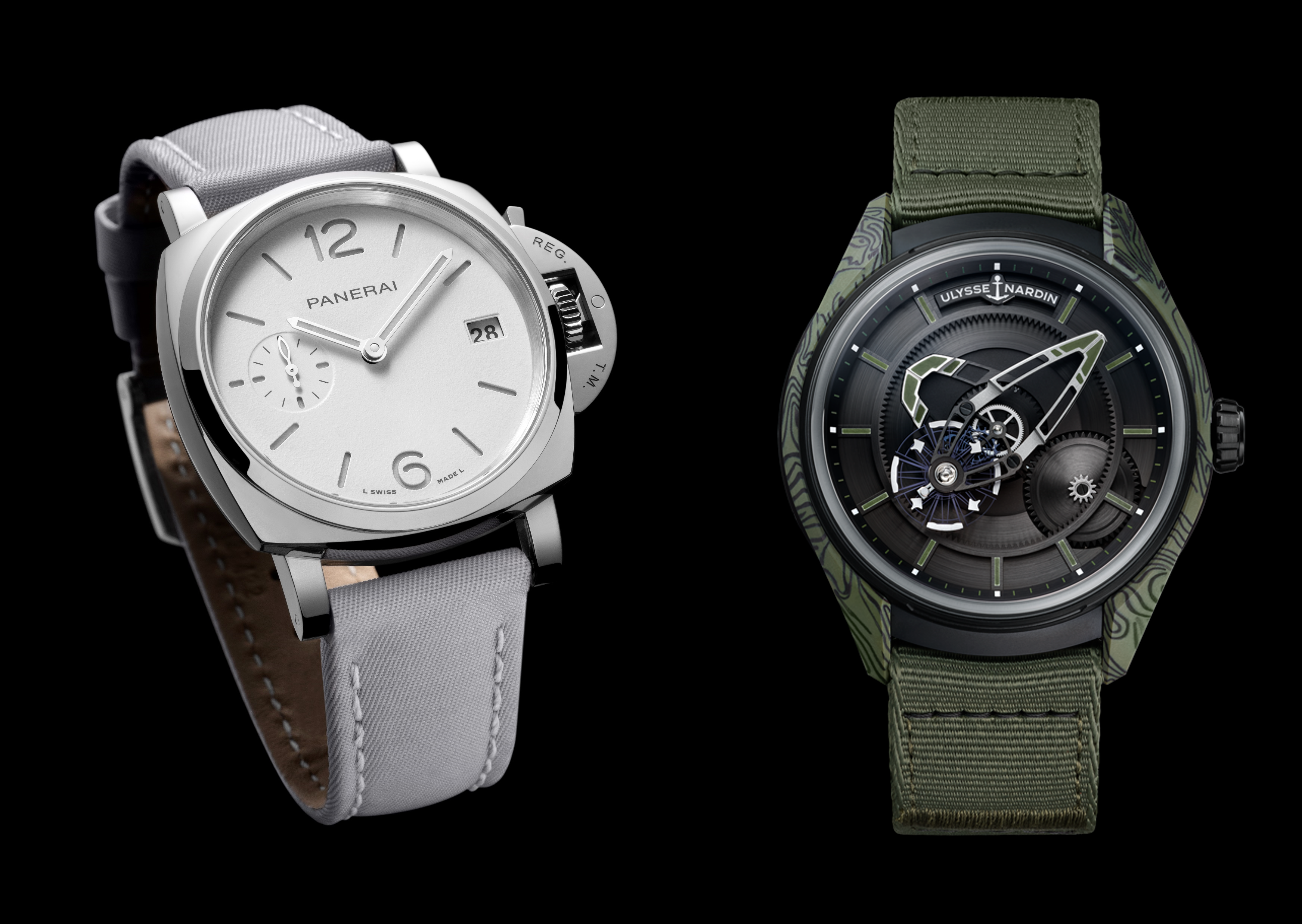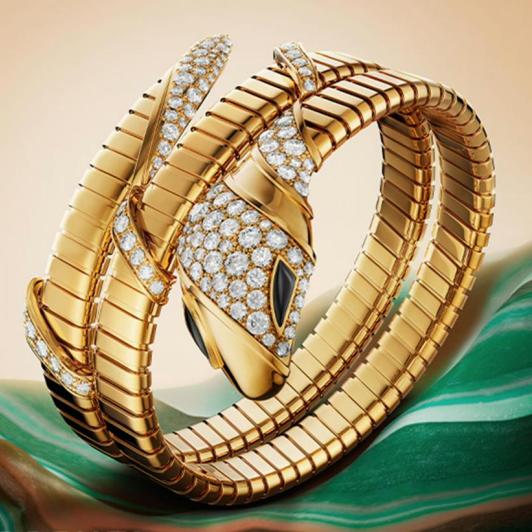“I first came to China when I was 25 years old, and of course, I love Shanghai,” said Miuccia Prada, aged 74, at the opening of the Pradasphere II exhibition in Shanghai.
On December 6th, it wasn’t just this third-generation leader of the Prada family who arrived in Shanghai, but almost all the core figures of this Italian luxury giant: Miuccia Prada’s husband, Patrizio Bertelli; their eldest son and the heir apparent to the Prada Group, Lorenzo Bertelli; Prada’s co-creative director Raf Simons; and Prada’s CEO Gianfranco D’Attis, among others.
The presence of so many significant figures underscores the importance of this exhibition to the brand and highlights the Prada management’s emphasis on the Chinese market.

From left to right in the photo: Patrizio Bertelli, Miuccia Prada, Raf Simons, Lorenzo Bertelli.
The Pradasphere exhibition first took place in London in 2014. This year, Shanghai was chosen as the first global location for the second chapter of the exhibition, Pradasphere II, curated personally by Miuccia Prada and co-creative director Raf Simons. The exhibition features nearly 200 fashion styles, some of which are being publicly displayed for the first time in 30 years; with over 400 pieces in total, it covers Prada’s collaborations in art, architecture, culture, sports, and more, presenting a rich cross-section of the brand’s 110-year history to the Chinese audience.
The Shanghai START Art Museum, where the exhibition is held, is covered in Prada’s signature green. Outside, there is a restored green train carriage, making it a popular spot for visitors. This massive exhibition is open to the public free of charge, from December 7th to January 21st, 2024, lasting one and a half months.
Currently, Prada is in a period of transition, both in management and creativity. At this critical moment, what message does Prada wish to convey to the Chinese audience through this exhibition?
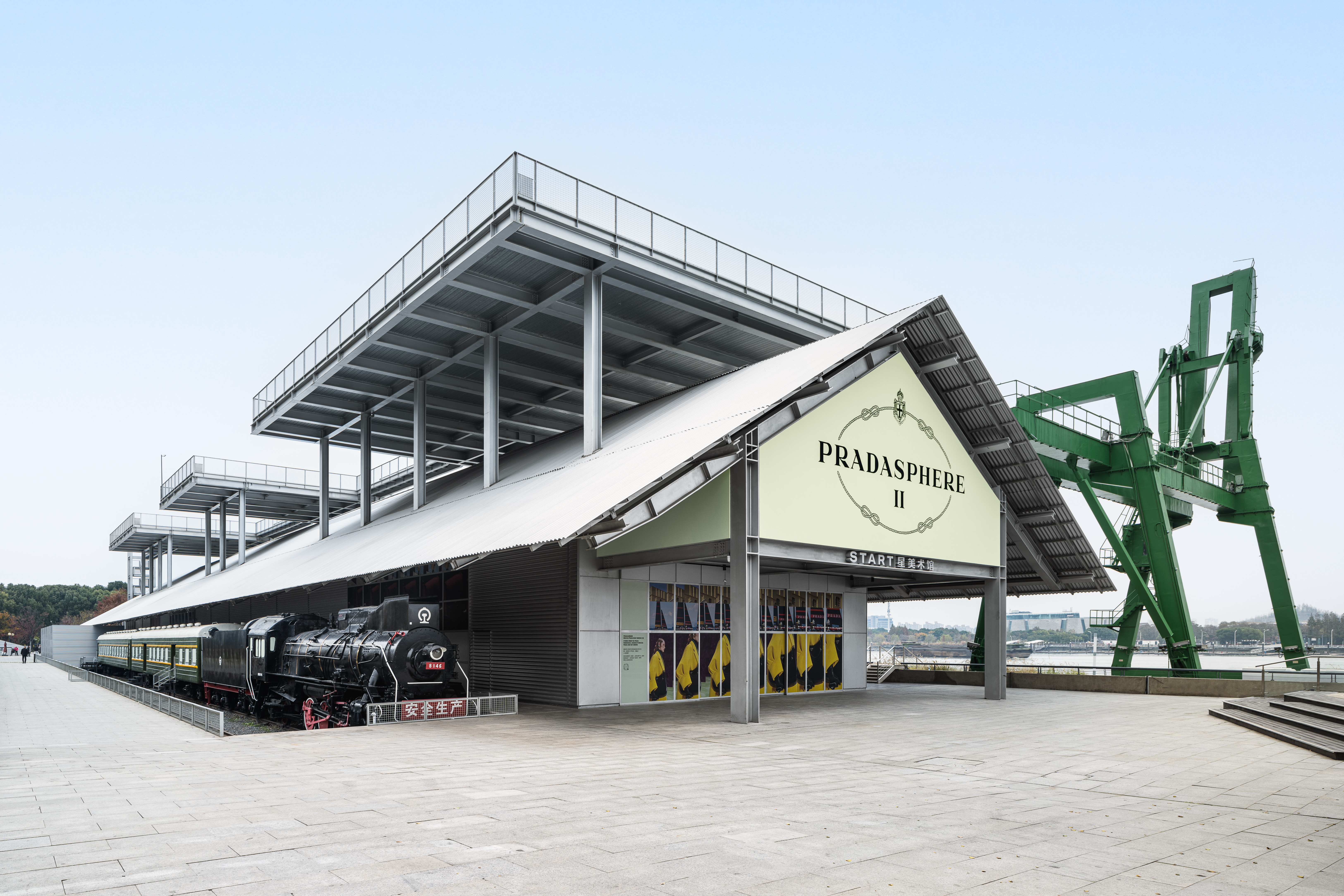
What Is Prada’s Exhibition About?
— 14 Major Sections Fully Demonstrate the Brand’s Accumulation
The key theme of Pradasphere II’s curation is “Magazzino” (Italian for “warehouse”). The space is arranged like a bountiful warehouse, with industrial shelving lined with precious pink velvet, creating a juxtaposition of roughness and refinement.

In the main exhibition hall, nearly 200 women’s and men’s fashion styles from 1988 to the present, carefully selected by Raf Simons, are displayed. Some of these pieces are being publicly displayed for the first time in over 30 years.
Models are placed on the upper and lower shelves, foregoing glass enclosures, allowing visitors to closely observe the details of the fashion pieces.
The fashion works are displayed chronologically, outlining the brand’s history and clearly distinguishing Prada’s stylistic evolution.
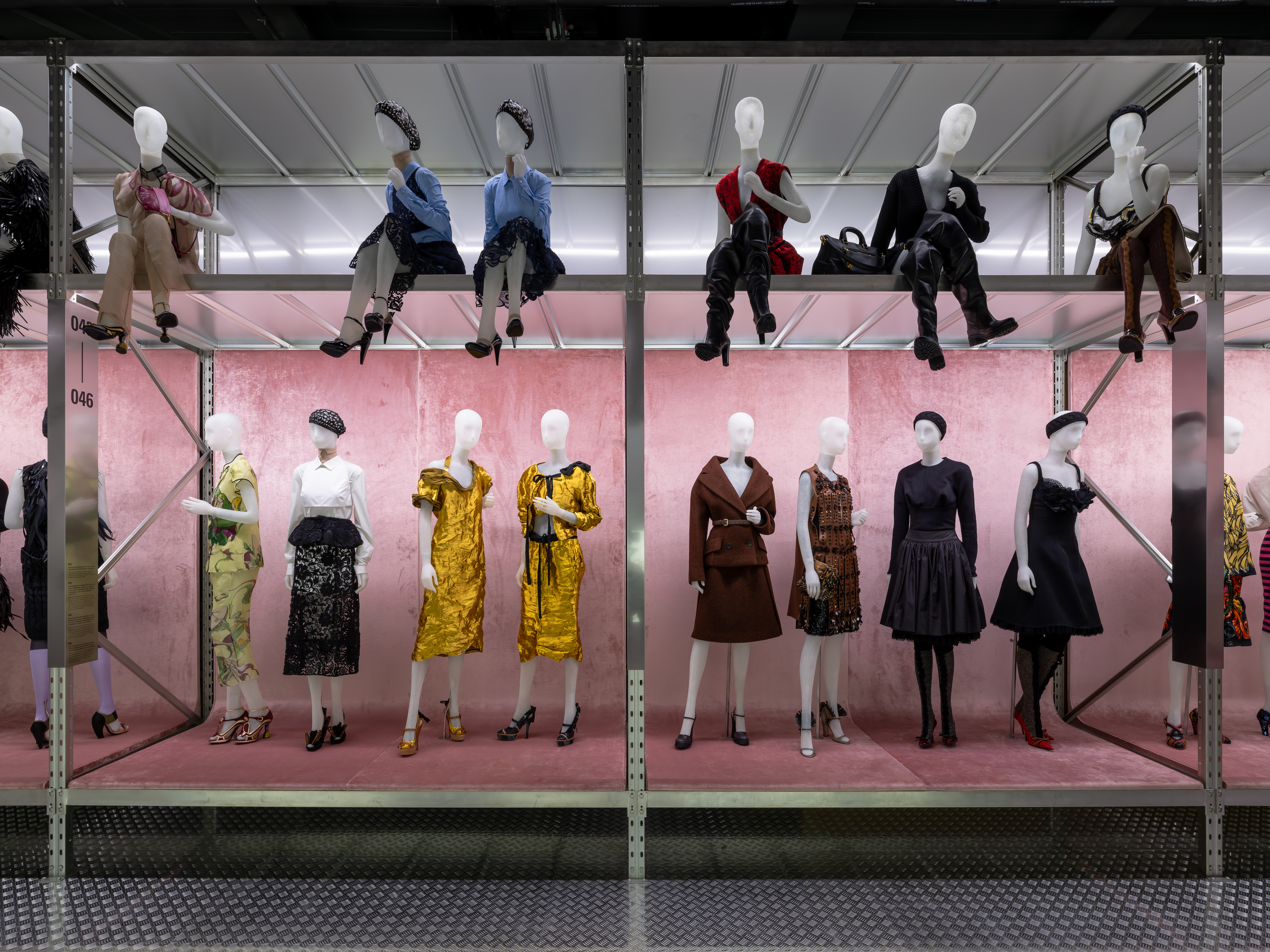
Multiple themed rooms extend from the warehouse corridor, leading visitors deeper into Prada’s rich world.
The Gallery displays 31 of the most precious handbags from the Prada fashion archives, reimagined by the renowned British contemporary artist Damien Hirst.
One Prada Galleria bag is placed in a glass cabinet filled with formaldehyde, continuing Damien Hirst’s iconic “Natural History” series. Another set of handbags has undergone chroming, resulting in a uniform silver surface.
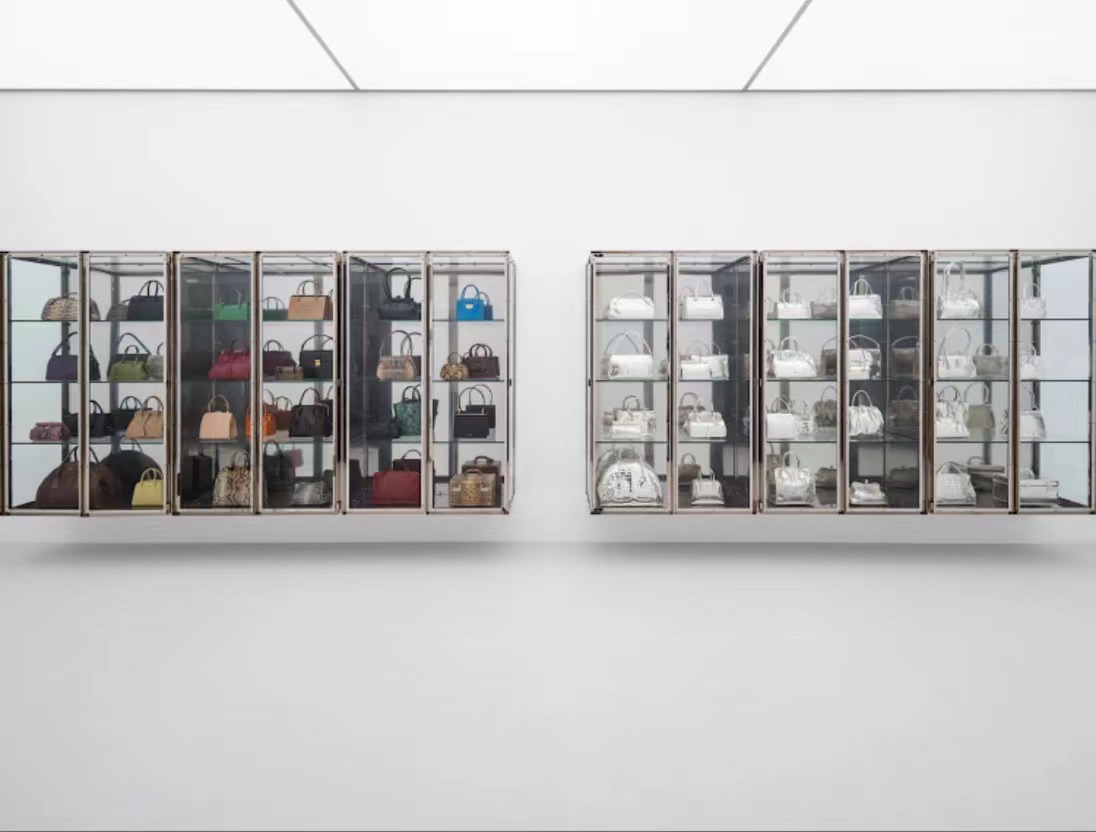
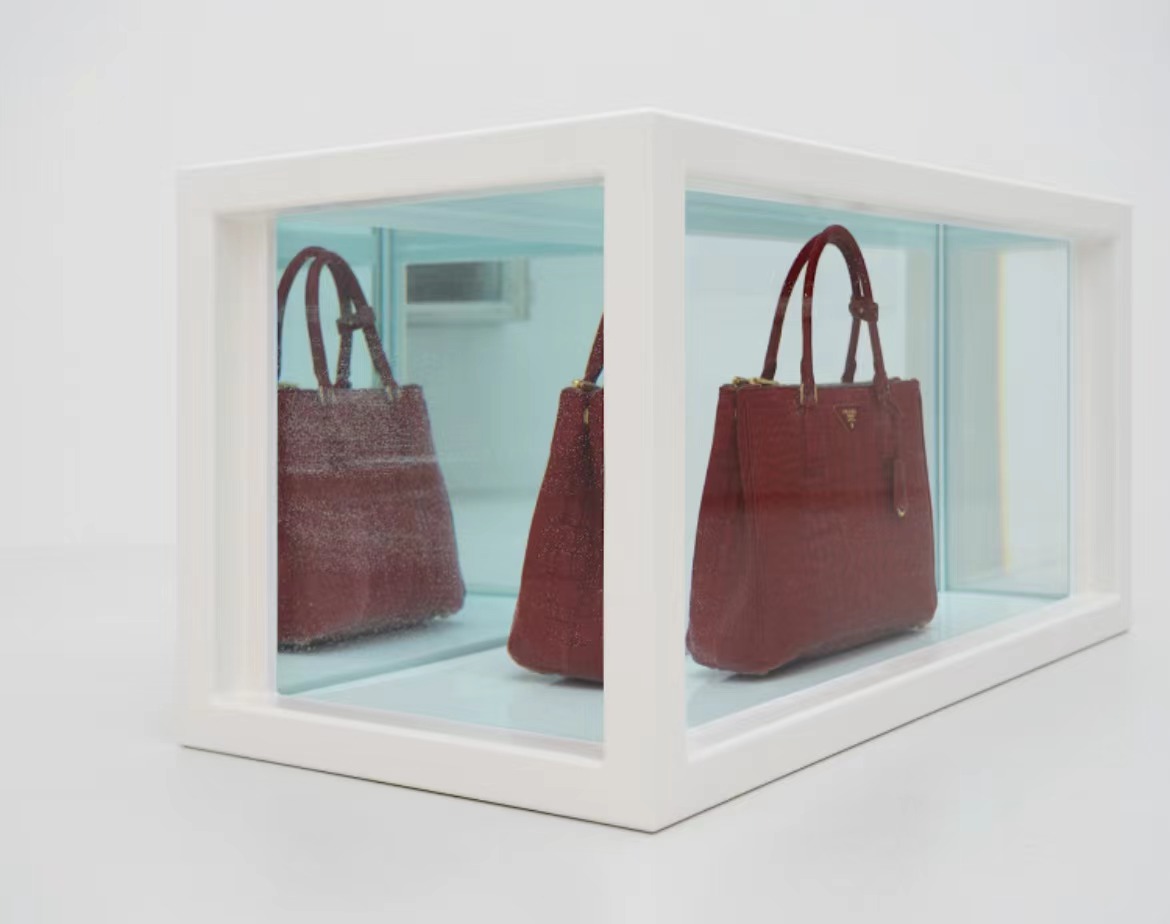
In the Materiality section, 20 skirts designed specifically for this exhibition are displayed for the first time, adorned with sequins, buttons, metal eyelets, and other elements, showcasing Prada’s exquisite craftsmanship.
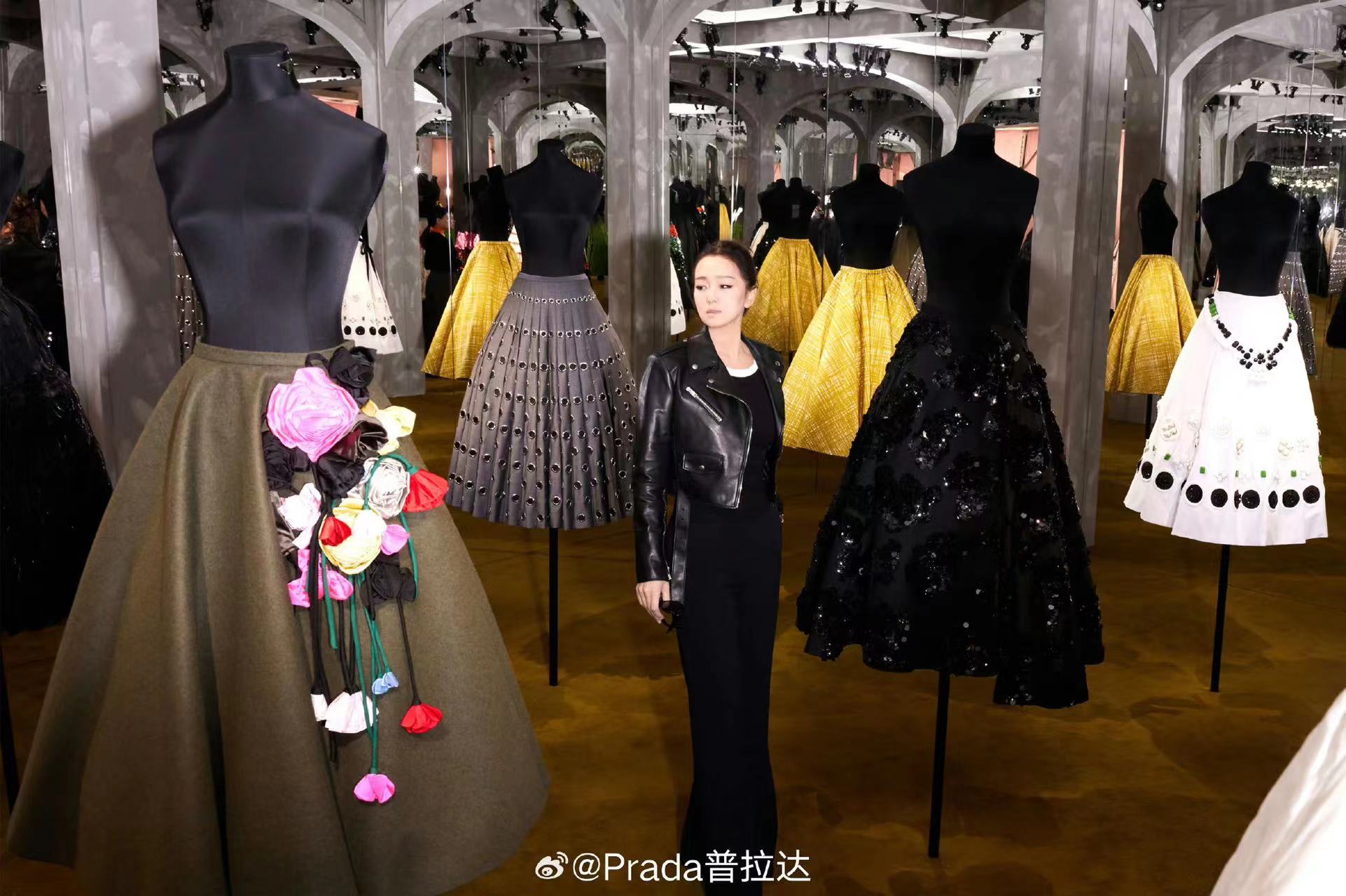
Gong Li in the Materiality exhibition room.
In other sections, Prada’s iconic recycled nylon (Re-Nylon) material, the sports Linea Rossa collection, the Prada Luna Rossa sailing team, and the Prada Art Foundation, among others, are all displayed.
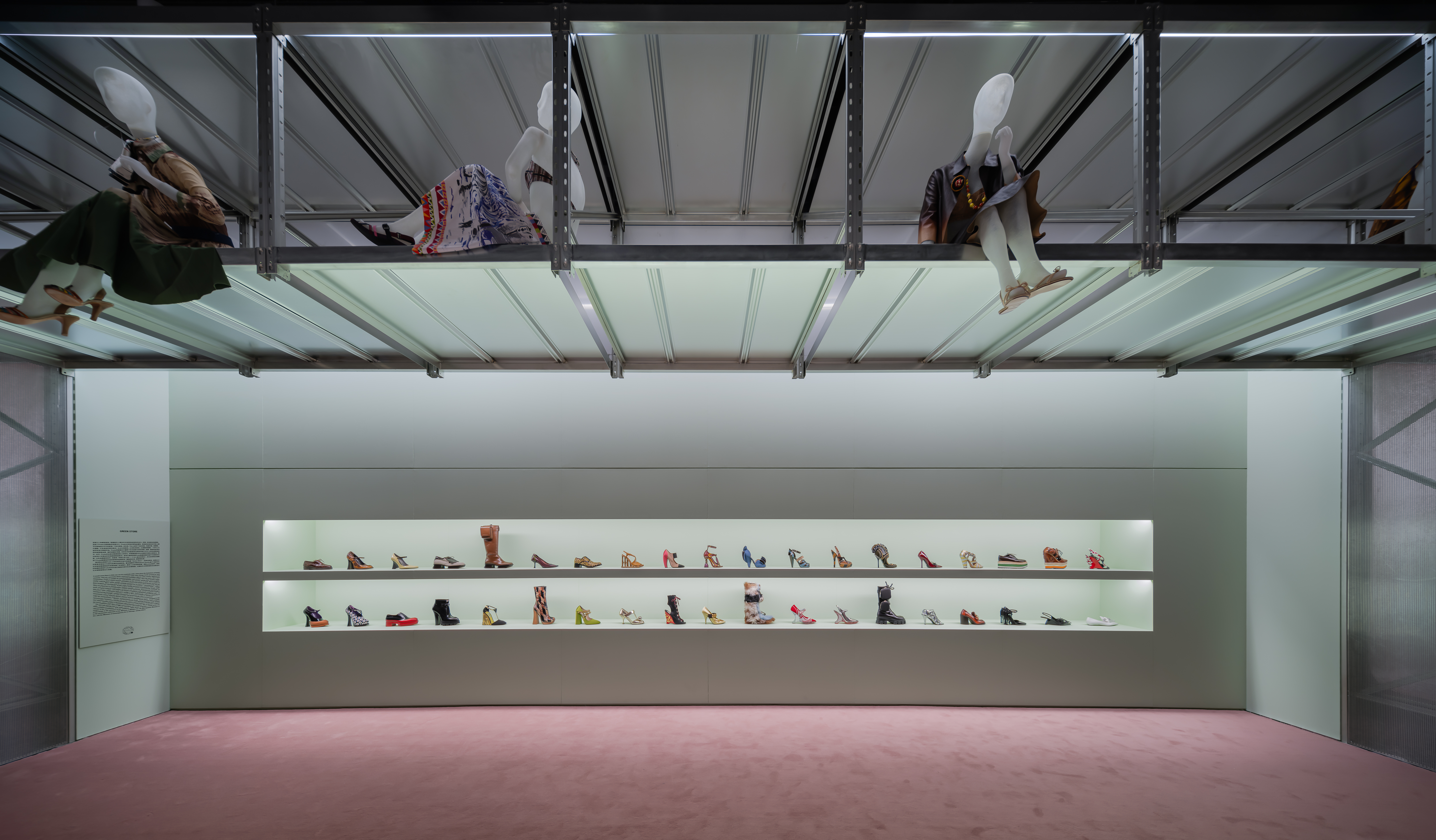
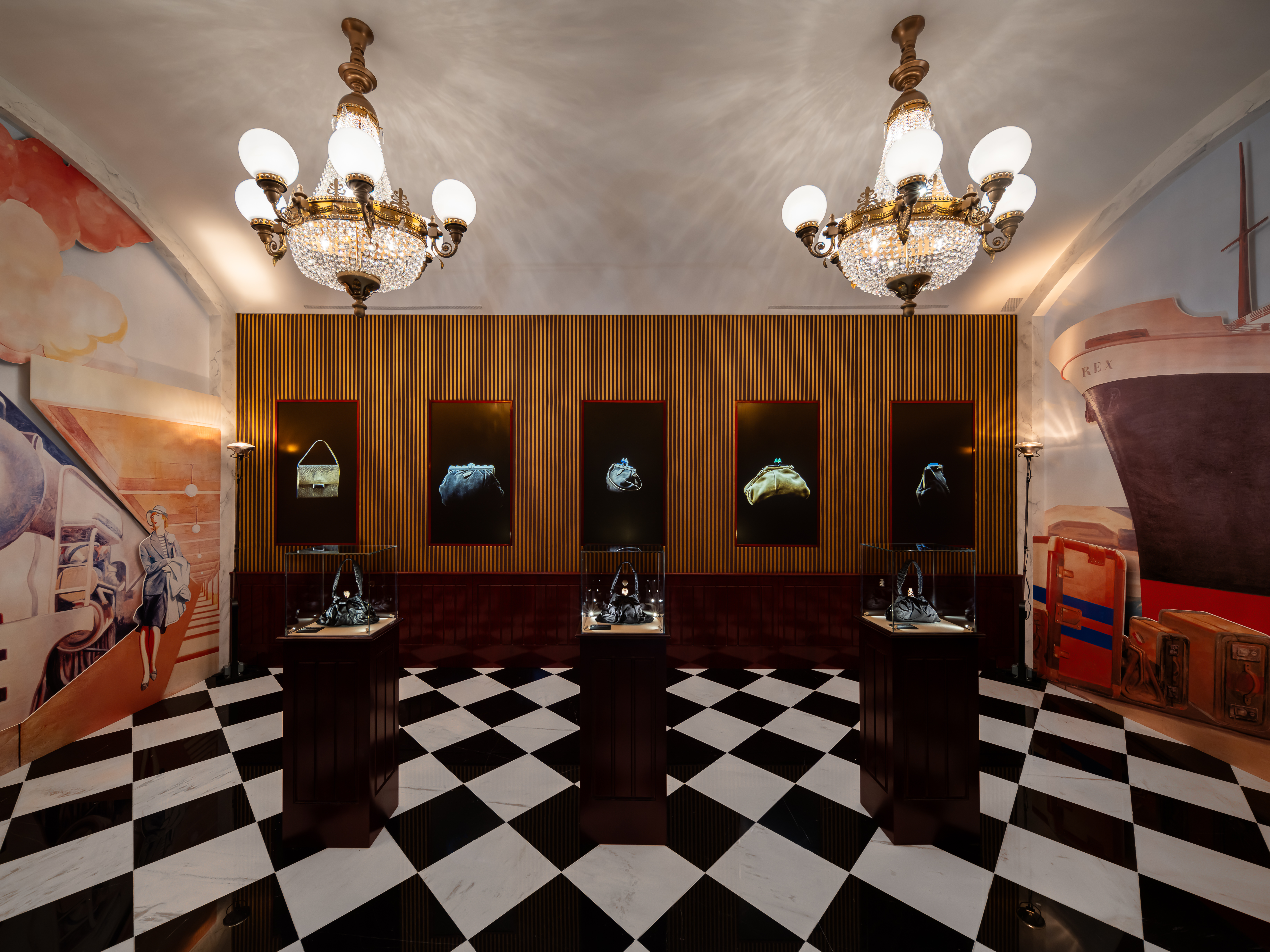
— Revealing the Complex World of “The Most Radical Thinker in Fashion”
Miuccia Prada, the soul of the brand, has shaped Prada’s unique contemporary temperament.
Known as “the most radical thinker in fashion,” her interdisciplinary experiences and complex thoughts set her apart in the fashion world. This exhibition offers Chinese audiences an important window into understanding Miuccia Prada’s complex world.
Before joining the family business in 1988, Miuccia Prada was active in several different fields. She was a feminist activist, earned a Ph.D. in political science, and trained in mime at the Piccolo Teatro in Milan.
Miuccia Prada has said she feels guilty for not pursuing a more significant, more political career.
This background explains her approach to creation at Prada, where she pioneered the use of synthetic materials like nylon in the luxury world. Her “Ugly Chic” style reflects her critical thinking about women’s dress codes…
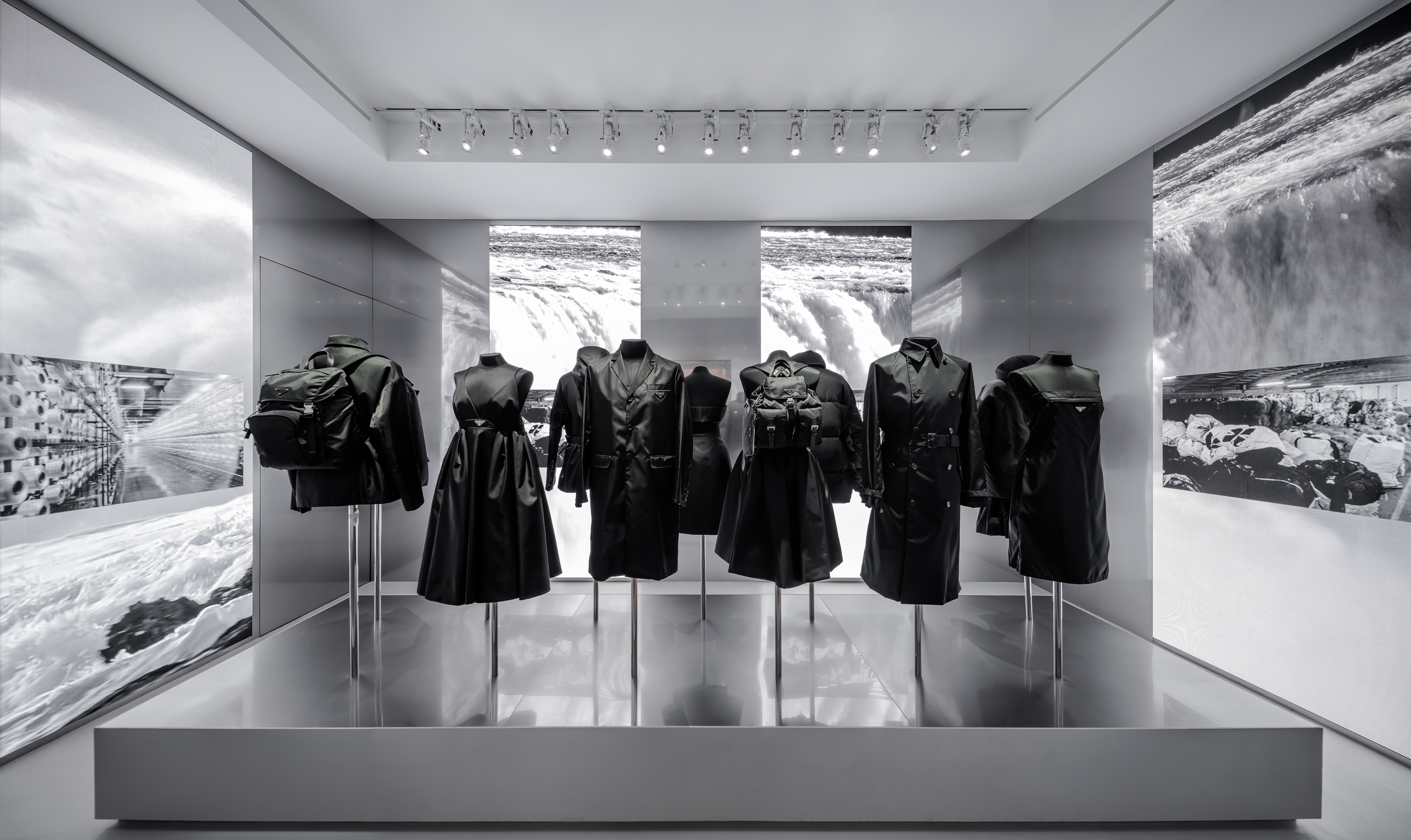
The Re-Nylon exhibition room.
Why Did Pradasphere’s Second Chapter Begin in China?
— Signifying a New Chapter for Prada
In today’s luxury goods industry, consumers have increasingly high expectations of brands, with a clear understanding of their own needs and a desire for more from these brands. Prada continually tries innovative ways to interact and communicate with consumers, as exemplified by hosting the Pradasphere II exhibition in Shanghai.
Miuccia Prada mentioned: “The underlying logic of Prada is that we want to make culture and art more attractive. If we cannot output attractive culture and art, no one will want to listen to us.”
Miuccia Prada has long held sole control over the brand’s design narrative. In the second chapter of the Pradasphere exhibition, she has given space to Raf Simons.
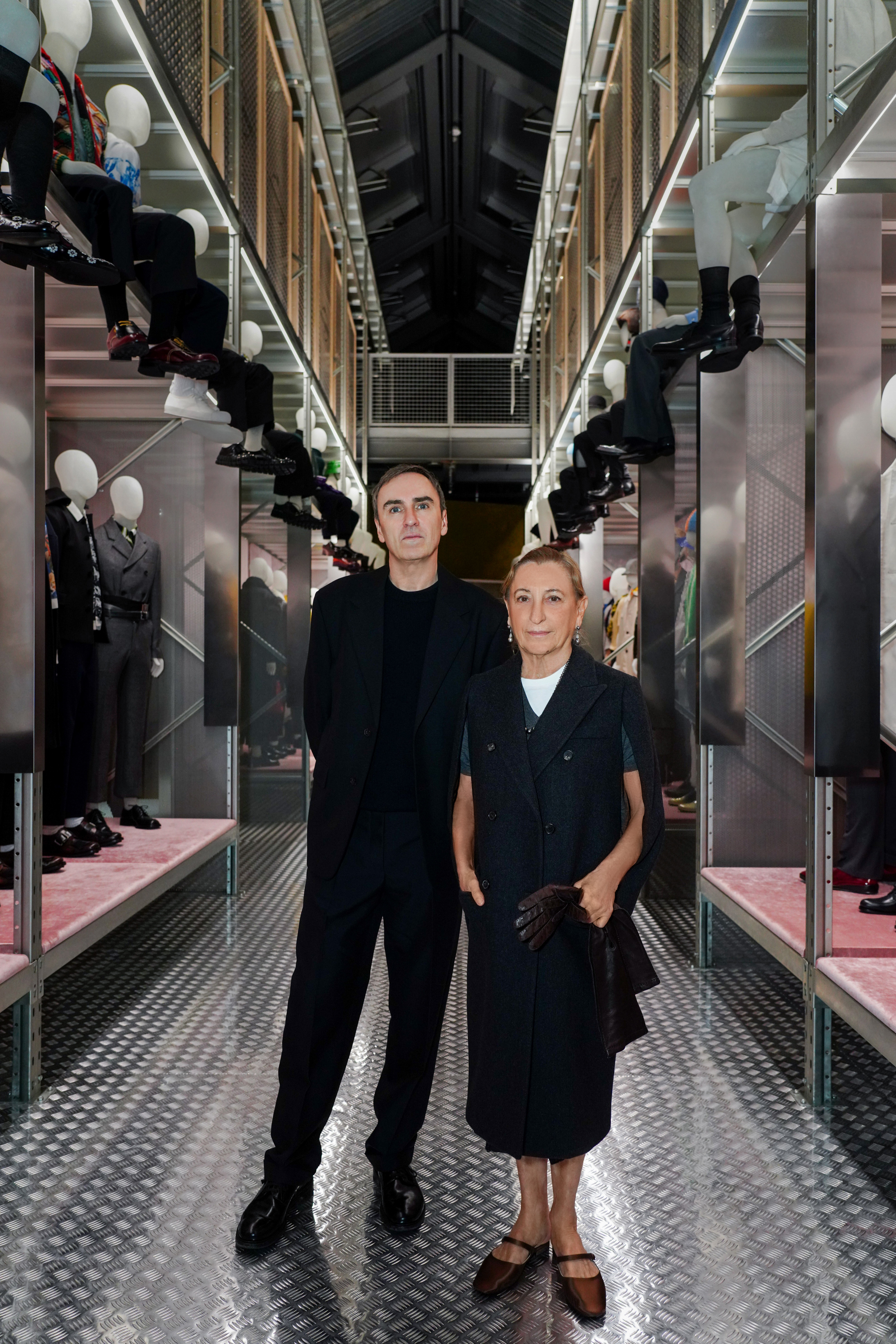
Raf Simons joined Prada in 2020 as co-creative director alongside Miuccia Prada. In November 2022, he closed his eponymous label to focus on his work with Prada.
Since his appointment, Raf Simons has spent much effort sifting through the brand’s archives, both as a necessary task for a newly appointed creative director and in preparation for this exhibition.
Miuccia Prada handed over the power to Raf Simons to decide the fashion theme of this major exhibition. The garment curation in the main exhibition hall warehouse corridor was entirely managed by Raf Simons. Miuccia Prada was responsible for the displays related to architecture, art, film, and other aspects.
Whether in design or management, Prada is currently at a moment of transition. In January this year, Prada Group appointed Andrea Guerra, a senior advisor to LVMH Group, as CEO and Executive Director, succeeding Miuccia Prada and Patrizio Bertelli to steer the business, assisting their son Lorenzo Bertelli in a smooth succession.
— Prada’s Key Opportunity in China
On the other hand, choosing China as the first location for this significant exhibition underscores Prada’s emphasis on the Chinese market.


The photo shows the Shanghai START Art Museum, where Pradasphere II is located, demonstrating Prada’s deep connection with local Chinese culture in the curation process. The museum, formerly China’s first sea-to-land railway transfer platform “Rihui Port Warehouse,” and once a cargo and passenger train station, retains its warehouse-style architecture and train platform layout, including a section of railway track, riverside gantry cranes, a locomotive, and several green train carriages.
Prada Group CEO Andrea Guerra emphasized the importance of the Chinese market in the July Q2 earnings call this year, saying, “If there is another opportunity for Prada, it is definitely in Asia, especially China.”
Gianfranco D’Attis, CEO of Prada, now visits China every two months. He said in a recent interview in Shanghai: “China holds a very important strategic position in Prada’s global market.”
D’Attis revealed that Prada’s medium- and long-term goal in the Chinese market is to double its sales, and increasing investments in marketing, communication, and other areas is a crucial path to achieving this goal.
Through this exhibition in Shanghai, Prada hopes to let Chinese consumers feel that it is a tangible brand, not just an abstract brand and lifestyle. Moreover, exhibitions have always been an important aspect of Prada’s brand communication and cultural exchange activities in the Chinese market in recent years.
It is noteworthy that Prada’s series of communication activities in the Chinese market have also sparked widespread discussions on social media. This is partly due to the events themselves and partly due to Prada’s continuous presence on mainstream Chinese social media platforms, especially the online interactions complementing offline events, forming an important part of the brand’s communication strategy in the Chinese market.
This year, Prada’s social media popularity in China has continued to rise, with several major marketing events frequently trending. For example, when it was announced as the official partner of the Chinese women’s football team in July, the hashtag #Prada找对人了# dominated Weibo’s hot search; during Milan Fashion Week, topics like #Prada米兰女装秀# sparked heated discussions; and the “Seed Project” collaboration with independent flower shops in cities like Shanghai and Beijing generated much discussion about #Prada种子计划# on Weibo.

How Does Prada Expand the Influence of the Exhibition?
Exhibitions are where the brand culture deeply connects with people, and offline spaces are crucial for brands to tell stories and convey ideas.
However, it must be acknowledged that the reach of offline events is limited. As China is at the forefront of global digitalization, Chinese consumers have entered an era of data and content.
Therefore, in the Chinese market, online platforms become another important carrier for brand storytelling and a breakthrough to widen the reach of offline events.
Around this major exhibition, Prada has also explored digital avenues, ensuring this well-planned, significant exhibition reaches a broader
audience and achieves greater communication impact.
A week before the exhibition’s opening, the Weibo topics #prada上海大展# and #prada仓库故事# had already accumulated 1.16 billion views and over 2.25 million discussions. On Douyin, #PradasphereII had 16.25 million views, and on Xiaohongshu, #Prada仓库故事 had 930,000 views.

For this event, Prada chose to collaborate deeply with Weibo, transforming the visual and cultural experiences of the offline exhibition into the online space, establishing efficient, emotionally connected communication with more online users.
Data shows that in the first half of 2023, the social media volume of the luxury goods industry on Weibo exceeded 130 billion, a 39% increase compared to the first half of 2022.
In this collaboration with Weibo, we see Prada leveraging three major capabilities of Weibo to “project” Pradasphere II into the online space:
1. Precisely reaching industry interest groups.
Prada’s exhibition event on Weibo attracted wide attention from interested groups. Beyond the substantial volume of attention, Weibo’s unique interest groups, including those interested in luxury and fashion, provided a tonally aligned online communication environment for luxury brands.
Notably, on Weibo’s highly followed Discovery page, Prada presented a green creative package board in line with the exhibition’s main color, capturing users’ immediate attention. Accompanying the exhibition’s opening dinner, Prada also launched a Discovery page overlay on Weibo, attracting brand interest users with keywords like “Prada” and “普拉达.”
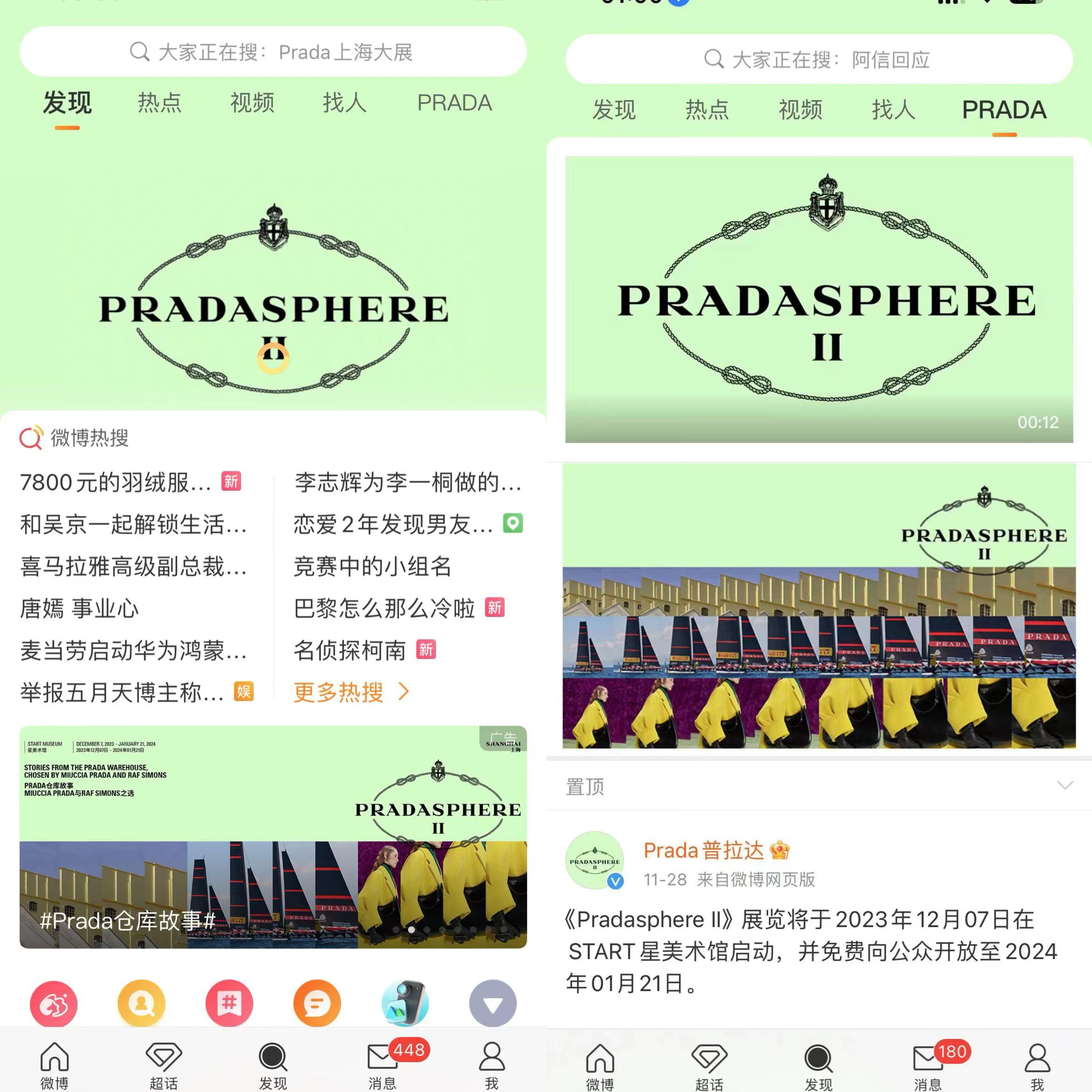
2. Outputting in-depth content for interest groups.
Prada actively collaborated with Weibo’s fashion IPs and opinion leaders in various fields to produce characteristic content suitable for online dissemination.
For example, the collaboration with Weibo’s fashion IPs effectively interpreted the highlights of the exhibition, helping the online exhibition information reach more online audiences and directing online users to the physical location for a firsthand experience.
Customized topics like #上海最值得看的展览# (translated to mean exhbitions worth visiting in Shanghai) and #了不起的尼龙工艺# (translated to mean remarkable nylon works), in collaboration with Weibo bloggers in humanities, history, sports, art, and lifestyle, offered multi-angle in-depth content. This approach provided more attractive story packaging and extended interpretations of the exhibition, fully explaining Prada’s history, craftsmanship, and cultural core.
Prada’s content collaboration with Weibo was not a mere “replica” of the offline exhibition. It not only adapted to the online communication ecosystem but also extended the information contained in the offline exhibition. It provided a discussion forum for luxury and fashion interest groups and strengthened the brand’s cultural impression among a broader online audience.
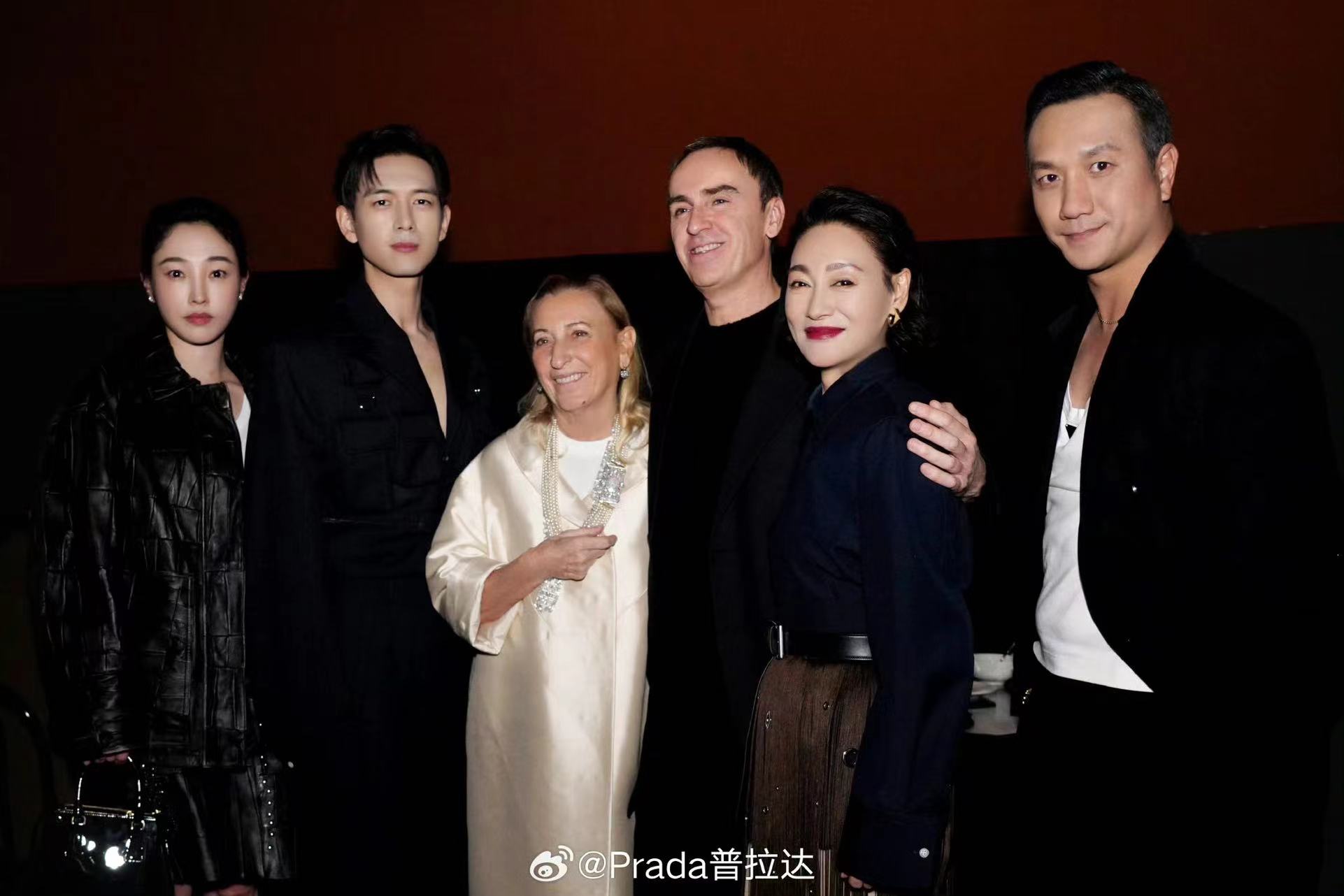
3. Maintaining topicality, igniting event popularity.
For a brand event like Pradasphere II, lasting nearly two months, maintaining its topicality throughout the communication cycle is also a crucial aspect of Prada’s online communication strategy.
Whether related to celebrity hot search topics or customized topics for the exhibition, Pradasphere II frequently appeared on Weibo’s hot search, significantly increasing the exhibition’s online visibility. “Hot search” is perhaps most users’ first intuitive understanding of Weibo. In reality, hot search represents Weibo’s strong field capacity.
Weibo’s hot topic public opinion field capacity can help luxury brands rapidly accumulate social assets. Today, under the performance of Weibo’s hot topic field capacity, it brings more value to breaking the circle for exhibitions and other brand marketing events, giving luxury brands enormous imaginative space in business communication.
Conclusion
“If I had to summarize Prada in three words, they would be critical, adventurous, and conflicting. At the same time, we are also a humble, always introspective, and authentic brand,” said Gianfranco D’Attis, CEO of Prada, describing the brand’s distinctiveness.
Exhibitions are an important battleground for cultural exchanges for brands, opening a window for them to voice and showcase their multifaceted nature, presenting to the world Prada’s insights into art, culture, music, architecture, and other fields. Combined with an orderly planning of online communication rhythms, Prada has simultaneously constructed a long-cycle cultural exchange circle online, imprinting the cultural core of the exhibition more deeply in the minds of its audience.
In this context, Weibo, as China’s leading social platform, plays an indispensable role in bringing unique value to a culturally relevant brand event.
| Image Credit: Prada’s official Weibo account; provided by Prada and Weibo
丨Reporter: Jin Daixi
| Editor: Zhu Ruoyu

